- Home Improvement
- Property News
- Advertise with us

- Resources & Guides

Free Deed of Assignment Tenancy Agreement Sample Form and Template
A Deed of Assignment is a legal document that transfers the ownership rights and interests of a property or asset from one party, known as the assignor, to another party, known as the assignee. It is commonly used in real estate transactions but can also apply to other types of assets such as intellectual property rights, stocks, or contractual rights.
The Deed of Assignment serves as evidence of the transfer of ownership and provides a clear record of the transaction. It outlines the terms and conditions of the assignment, including the details of the parties involved, a description of the property or asset being assigned, and any applicable terms or conditions.

Key elements typically included in a Deed of Assignment are:
- Parties: The document identifies the assignor (current owner) and the assignee (new owner) involved in the transaction. It is essential to provide accurate and complete information about both parties.
- Description of the property or asset: The Deed of Assignment should include a detailed description of the property or asset being transferred. For real estate, this includes the physical address, boundaries, and any relevant identifying information. In the case of other assets, it may include specific details such as patent numbers or stock certificates.
- Consideration: Consideration refers to the value or payment exchanged in return for the assignment. It can be in the form of money, goods, services, or any other agreed-upon consideration. The Deed of Assignment should clearly state the consideration provided by the assignee to the assignor.
- Terms and conditions: This section outlines the specific terms and conditions of the assignment. It may include any restrictions, warranties, or obligations that the assignee must adhere to after the transfer of ownership. These terms are mutually agreed upon by both parties and are legally binding.
- Signatures and witnessing: To make the Deed of Assignment legally enforceable, it requires the signatures of both the assignor and the assignee. Additionally, it is common to have witnesses present during the signing of the document to validate its authenticity.
Once the Deed of Assignment is signed and executed, it becomes a legally binding agreement between the assignor and the assignee. It ensures that the assignee acquires the rightful ownership of the property or asset, and the assignor relinquishes their ownership rights.
It is important to note that the requirements and legal implications of a Deed of Assignment can vary depending on the jurisdiction. Consulting with legal professionals or experts in the relevant field is recommended to ensure compliance with local laws and regulations.
When Can A Contract Be Signed As A Deed?
Under certain circumstances, a contract can be signed as a deed, distinguishing it from a standard contract. This is typically the case when the parties involved agree that no consideration, or payment, is necessary for the agreement to be valid.
As a more formal document, a deed follows a specific execution process. It requires the presence of a witness during the signing and in some cases, the use of a seal to authenticate the deed.
Is it Possible to Reverse a Deed of Assignment?
Once a deed of assignment has been executed and dated, it remains legally binding and enforceable until specific actions are taken. These actions include varying the deed using a deed of variation, surrendering it using a deed of surrender, or selling the property involved. If you intend to make changes to the original deed, it is more common to surrender the entire deed and then create a new deed with the desired modifications.
Which document do I require, a deed of assignment or a deed of trust?
When it comes to transferring the beneficial interest in land or property from one party to another, a deed of assignment is typically utilized. This document focuses solely on the assignment of the beneficial interest. On the other hand, a deed of trust can serve the same purpose but includes additional clauses that outline procedures for selling the property, among other things.
For most married couples seeking to assign their beneficial interest in an investment property, a deed of assignment is suitable for their needs.
Download a Deed of Assignment Tenancy Agreement Template
If you like a custom, completely personalised assignment agreement, use the link below. It takes about 5 min to create and you will end up with an agreement, tailored to your specific property.
Download CUSTOM Assignment Agreement
Alternatively, if you just want to download a generic deed of assignment of tenancy template, use the link below.
Download GENERIC Deed of Assignment of Tenancy Agreement
All content on this form and other forms for landlords published by Property Division are provided “as is”, with no guarantees of completeness, accuracy or timeliness, and without representations, warranties or other contractual terms of any kind, express or implied. Property Division does not represent or warrant that this letter or other material supplied by Property Division will be accurate, current, uninterrupted, error-free or omission-free.
Can a landlord refuse to assign a lease in the UK?
In the United Kingdom, a landlord’s ability to refuse to assign a lease is governed by the terms of the lease agreement and relevant landlord and tenant laws. The Landlord and Tenant Act 1988 (as amended) provides certain protections and guidelines for both landlords and tenants regarding the assignment of leases.
Here are some key points to consider:
- Lease Agreement Terms: The terms of the lease agreement will typically outline the conditions and requirements for assigning the lease. Some leases may include provisions that require the tenant to obtain the landlord’s consent before assigning the lease.
- Reasonable Refusal: The Landlord and Tenant Act 1988 imposes certain restrictions on a landlord’s ability to unreasonably withhold consent to an assignment. Generally, the landlord’s refusal must be reasonable, and they cannot arbitrarily deny permission. Common reasons for refusal may include concerns about the financial stability of the proposed assignee or if the assignee’s intended use of the property violates the terms of the lease.
- Landlord’s Costs: The landlord may be entitled to recover reasonable costs incurred in considering the request for assignment. These costs should be outlined in the lease agreement.
- Procedure for Seeking Consent: The lease agreement may specify the procedure that the tenant must follow when seeking the landlord’s consent for an assignment. It is important for tenants to adhere to these procedures to ensure compliance with the terms of the lease.
- Landlord’s Remedies: If the landlord believes there are valid reasons to refuse consent, they may have remedies available under the lease agreement or applicable law. However, these reasons must typically be specified in the lease.
It’s important for both landlords and tenants to be aware of the specific terms of the lease agreement and to understand their rights and responsibilities under the Landlord and Tenant Act 1988. If disputes arise, seeking legal advice is recommended to ensure compliance with the law and the terms of the lease. Additionally, the laws and regulations may be subject to change, so staying informed about any updates is advisable.
RELATED ARTICLES MORE FROM AUTHOR
Handy contacts to have as a real estate property manager for your clients, what are the best insulation options for new homes, how to sell your propoerty successfully.
- Blog for us
- Privacy Policy
- Terms and Conditions
- Sample Contracts
FREE 17+ Deed of Assignment Samples in PDF | MS Word

A deed is referred to as a legal document that serves as an instrument used regarding the transfer, assignment, or bargain of a property or rights. Deeds need to be signed, sealed, and delivered so that it will be considered valid. Deeds are often associated with property transfers, like transferring the ownership of the title of a property to another.
Deed Assignment Samples Pdf Word
Teacher agreement contract samples, free 26+ investment agreement samples in pdf | ms word | google docs | pages, free 9+ shop rental agreement samples [ commercial, lease, tenancy ].
A deed of assignment is one type of deed that is used not only in legal practices but also in the business industry during sale and transfer transactions. We will be touching on this important legal document in this article analysis . Select deed of assignment samples and templates have been included in this article for your convenience. You may download these sample and templates for free. Useful information like what it is, its uses, its components, and many more are available here. Feel free to check them out below.
Deed of Sale and Assignment Lease Template
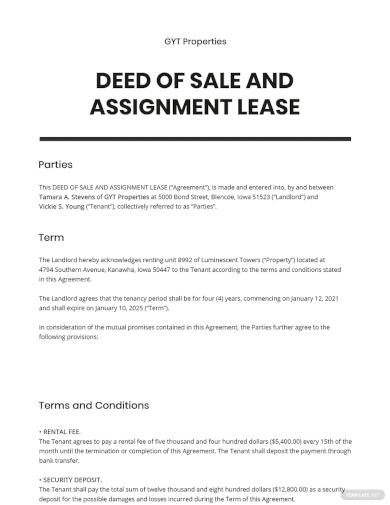
- Google Docs
Assignment of Deed of Trust Template
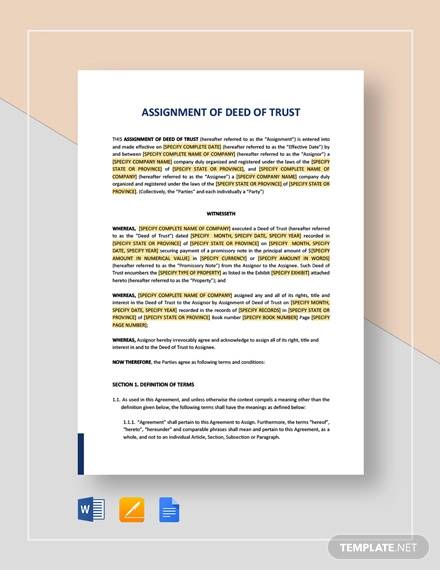
- Editable PDF
Size: A4, US
Deed of Reassignment and Retransfer Template
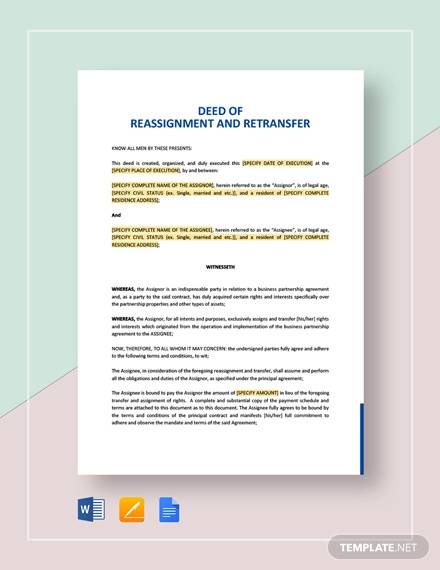
Editable Deed of Assignment Template

Sample Deed of Assignment Template

Size: 112 KB
Bank Deed of Assignment Template

Size: 11 KB
Sample Company Deed of Assignment Template

Size: 159 KB
Simple Deed of Assignment Template
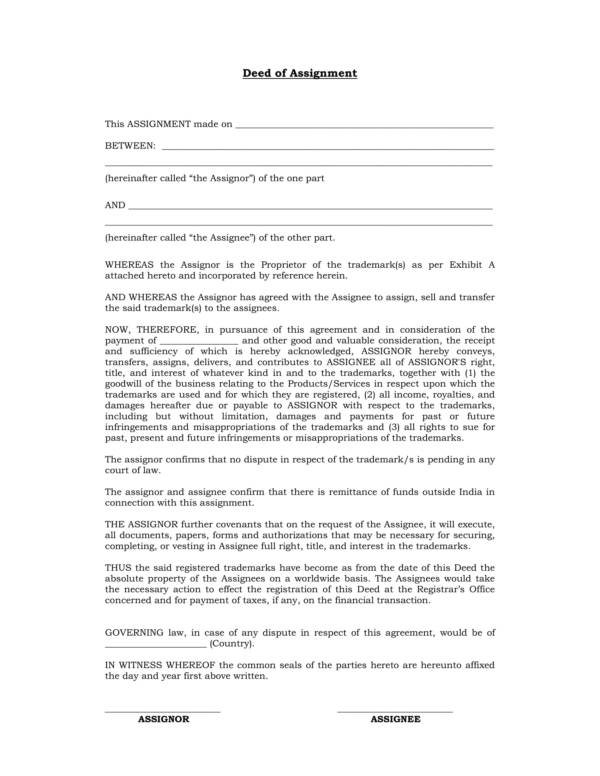
Size: 49 KB
Sample Assignment of Intellectual Property Rights (Pro-Assignee)
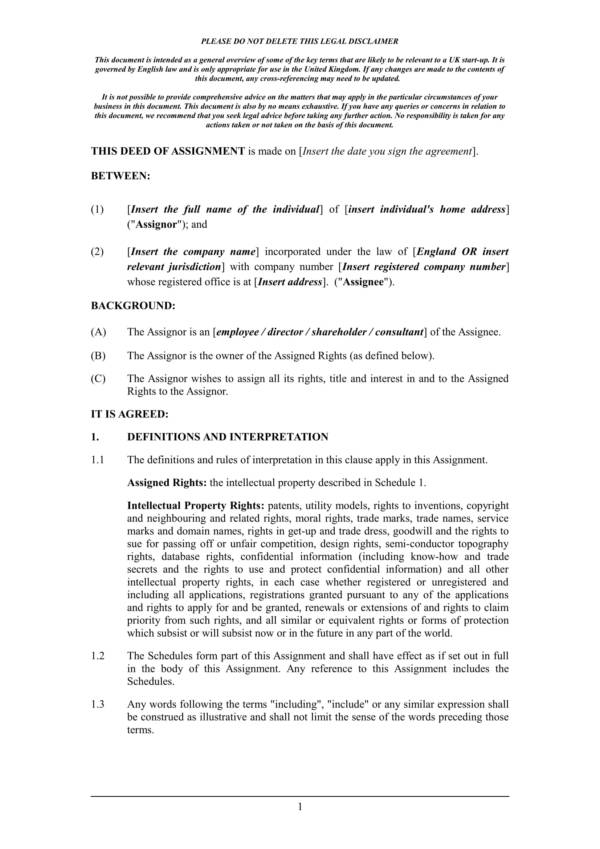
Size: 21 KB
Printable Deed of Assignment Template
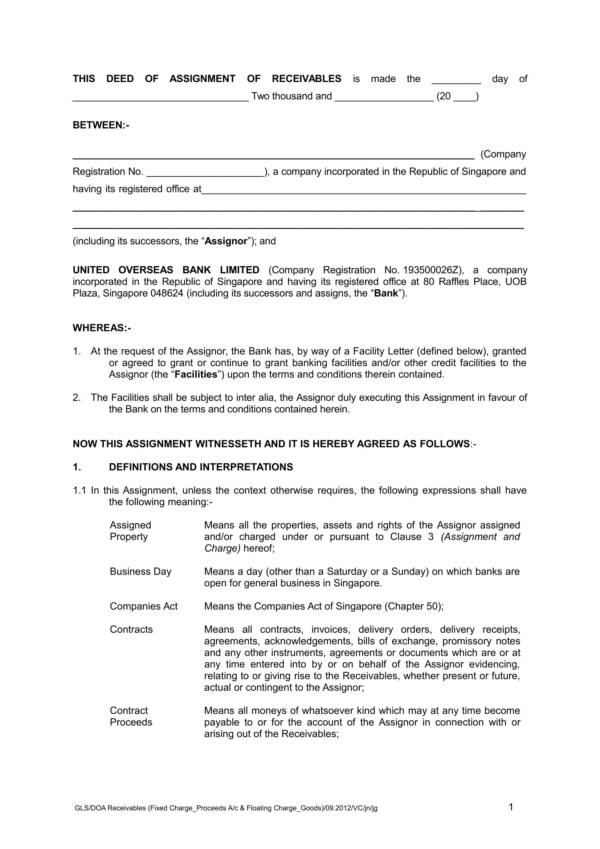
Size: 55 KB
Deed of Assignment of Shipbuilding Template
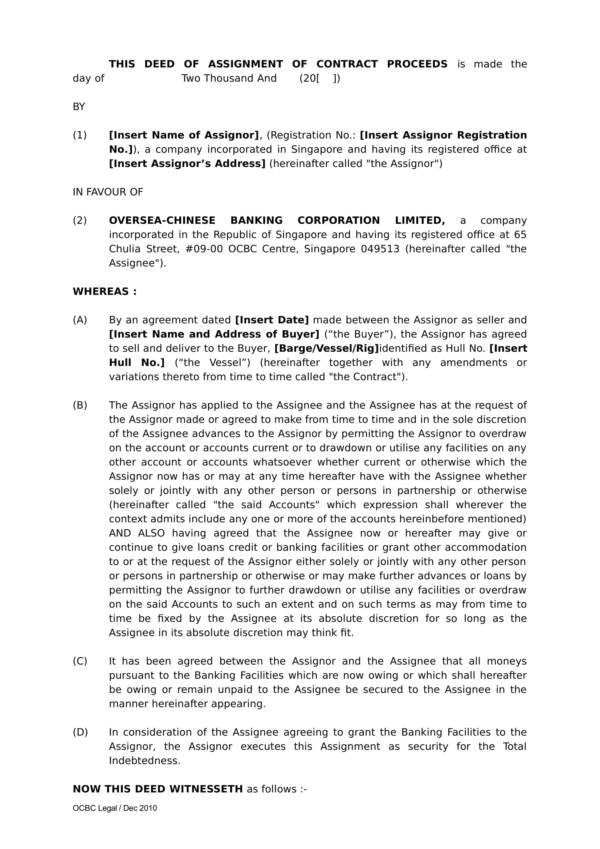
Size: 25 KB
What Is a Deed of Assignment?
A deed of assignment is a document that contains the details of a transaction that involves the transfer of ownership of a property from one entity to another. It works just like that of an sample agreement because a deed of assignment involves two parties in it who both need to agree to the terms and conditions of the assignment. The word transfer best determines or best describes what a deed of assignment is.
There will always be two parties involved in a deed of assignment and they are the assignee and the assignor. The the person or party who makes the transfer their rights to another person or party is called the assignor. The person who gets or receives the rights to a property or thing from the assignor is called the assignee. Both parties are important in the completion of a deed of assignment.
The concept of a deed of agreement is very similar to that of a legal agreement or legal contract, where there is a party who creates an offer and another party who accepts the offer. To learn more about deeds and other related topic, you may check out our website view them from there. To name a few examples are quit claim deeds, mortgage deeds , and sample grant deeds form .
How Is a Deed of Assignment Different from That of a Deed of Sale?
A deed of sale is also a sample form of document that transfers one’s rights on a property or thing to another. That is exactly the same as a deed of assignment. They may be used for the same reason, which is to transfer property rights, but there is still a difference between a deed of assignment and a deed of sale, which is evident in the details of each document and how they work. The following is a comparison that will help you understand their differences easily.
- A deed of sale is used mainly in real estate business plan to transfer the rights of the real estate holder, which is the seller, to that of the buyer once full payment for the real estate property is made. This transfer involves monetary payment by the buyer to the seller for the said real estate property. In a deed of assignment, the transfer of rights to a property may or may not require the assignee to make a payment for the said property nor does the assignor ask for payment for it.
- The buyer and the seller need to comply to the terms and conditions of the sales contract and they must do their share of responsibilities or obligations while the contract is still ongoing and even if the transfer has been completed. This is not the case in a deed of assignment. The transfer of rights is absolute, which means that once the transfer has been completed, the assignor no longer has anything to do with the property rights that they have transferred to another. In other words, they have totally given up all their rights to the said property or thing.
- A deed of sale is recognized by the law as the purchase or sale of a property, rather than a transfer of the rights of that property.
- A deed of sale may be seen as a takeover of rights while a deed of assignment may be seen as a transfer of responsibilities.
You may also be interested in other related topics, like sample warranty deed forms and general warranty deed samples .
Uses of a Deed of Assignment
What are the uses of a deed of assignment? There are a number of things that a deed of assignment is used for and they are as follows:
- A deed of assignment is used as an evidence that a certain transfer transaction has taken place between an assignor and the assignee.
- It is a document used to show that the assignor has transferred all of their rights, claims, interests, and ownership of a certain property to the assignee.
- It is a proof of the assignor’s promise that they are transferring their rights and ownership to the property to the assignee.
- A deed of assignment is not only used to transfer one’s rights to another, but it is also used to transfer the responsibilities or obligations of the assignor to the assignee. These responsibilities or obligations come together with the ownership and rights to the said property.
Real estate businesses and other businesses involved in the sale and purchase of different kinds of properties commonly use a deed of assignment together with other important legal documents, like real estate sales contract , property sales contract , and home sales contract .
What Are the Components of a Deed of Assignment?
There are a lot of components of a deed of assignment and it is important that you know of these components if you are going to study or get involved in one. Below is the list of the components of a deed of assignment that you need to know.
- The introduction, which includes the date when the assignment is made and signed, the commencement, the names of both the parties involved, and the recital
- The operative part, which includes the testatum or the witnesses, and other clauses like sample receipt clause, the consideration, the word grant, the parcel, the capacity of both the vendor and the covenant for the title, exceptions and reservations, and habendum
- Other miscellaneous clauses like the covenant for indemnity, both for assignor and assignee
- The testimonies
- The schedules
- The execution of the deed
Pipeline Company Deed of Assignment Template
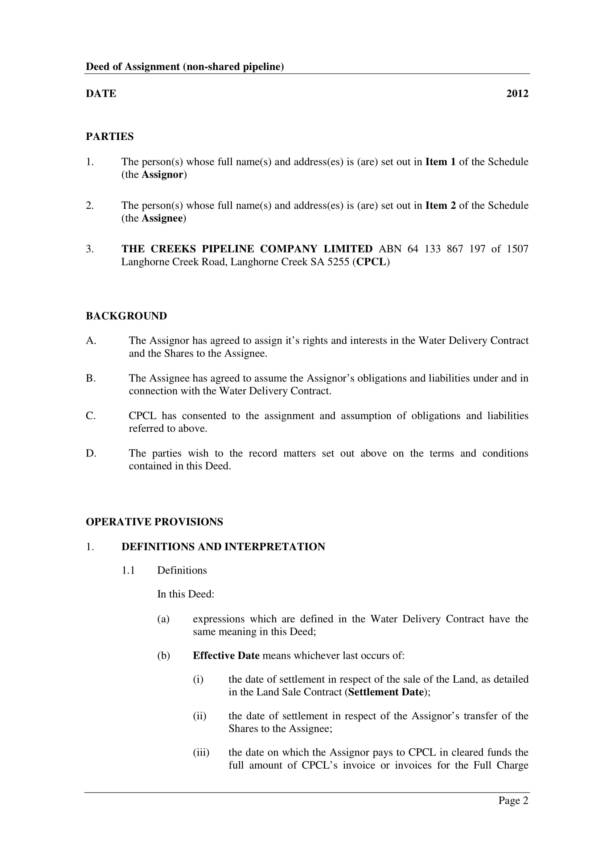
Size: 69 KB
Sample Deed of Assignment Form with Instructions Template
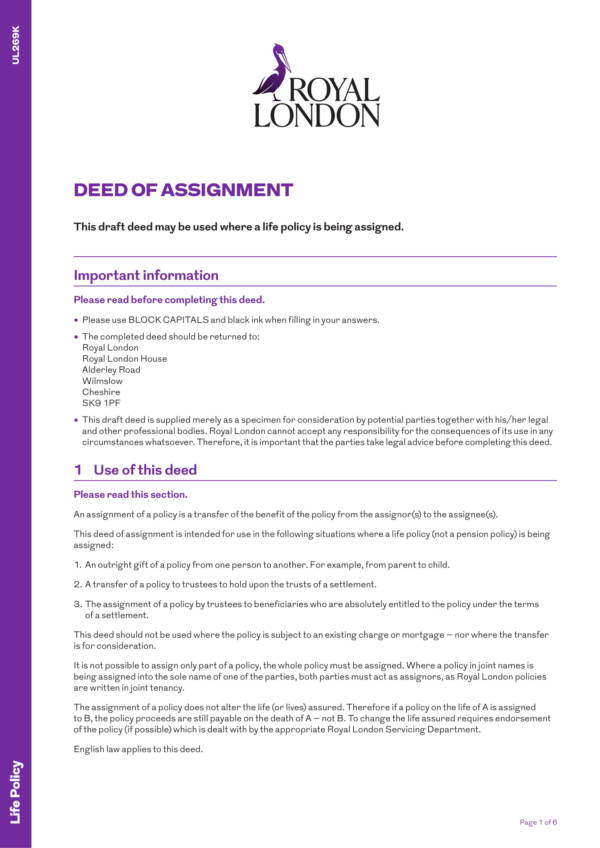
Size: 68 KB
Deed of Assignment of Contractor’s Financial Benefits Template

Size: 20 KB
Deed of Assignment of Tenancy Template
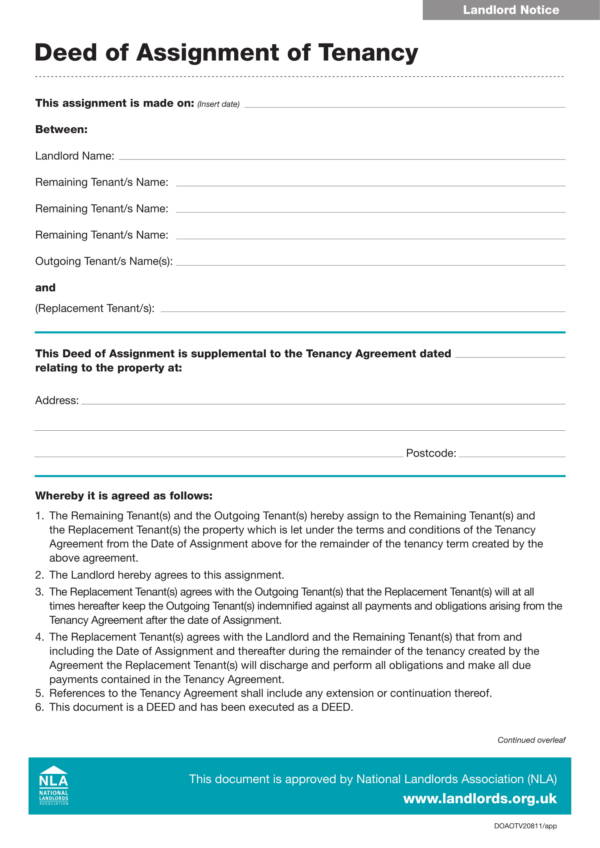
Size: 37 KB
Deed of Assignment of Trademark Template

Size: 12 KB
Deed of Assignment: Executors to Beneficiary Template
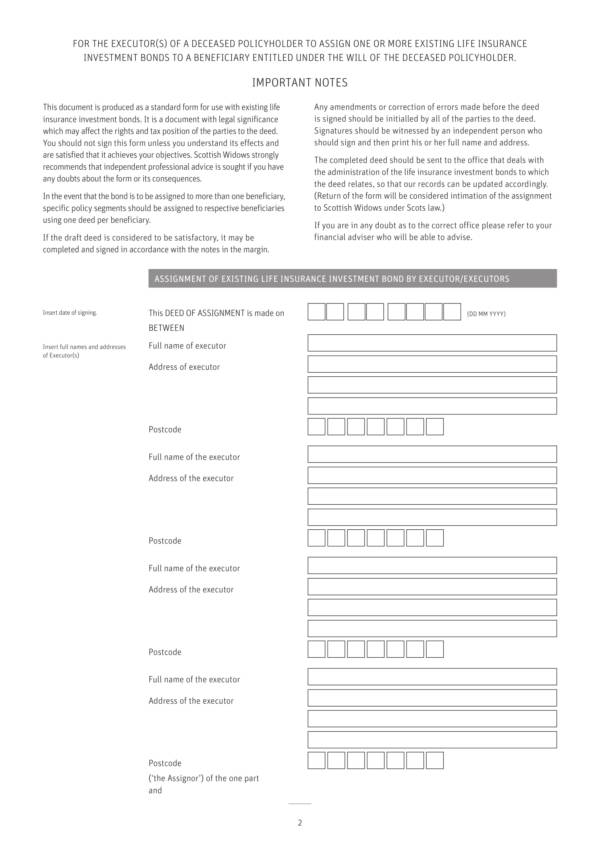
Size: 51 KB
Sample Deed of Assignment and Undertaking Template
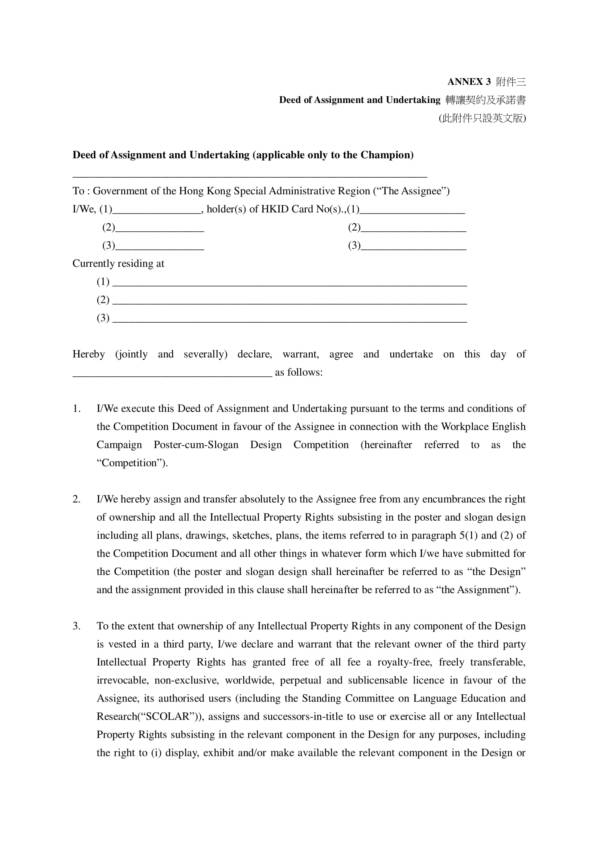
How to Create a Deed of Assignment
Believe it or not, you can create a deed of assignment on your own. You just need the right steps to guide you and the appropriate resources to help you have it done. Below are some easy-to-follow steps that you will really find useful.
- Decide what your deed of assignment is going to be about. Think of the details that you want to include in it that specifically has something to do with its transfer.
- If you must, list down these details and other specifications that you want to include in your deed of assignment.
- Once you have that decided or identified, go online and look for a deed of assignment template that contains the same details and specifications that you need, or a template that is similar to what you need.
- When you already found the template, download it to your computer or laptop. Also check if it the file type is supported by the sample applications you have on your computer or laptop, like Word or PDF.
- Open the downloaded file. If you need to change anything, or add and remove some parts, feel free to do so. Just make sure that it does not change the meaning of the paragraph, sentence, or part that you made changes to.
- When you are satisfied with the changes that you have made, go back to the very first page and review your work. Make sure that everything is covered in your document.
- After finalizing your work, save the changes that you have made. Saving your work allows you to retrieve it later on if you have a need for it in the future.
- Print enough copies that you need for your transaction.
Now you should have a deed of assignment of your own with your preferred details. Things get pretty easy and convenient with the use of templates. It is just like the one we did above. To get hold of other useful templates, feel free to visit our website and check a variety of templates from there. Other titles you may be interested in are Quit Claim Deed, Investment Contract , and Shareholders Agreement .
Advantages of Deed of Assignment Templates
With the steps above, you probably have an idea how great templates are. But its greatness does not stop there because more of it are in store for you. Below is a list of some of the advantages of a deed of assignment template.
- There are different varieties of deed of of assignment templates online so you can look for the template that is just right for your needs.
- The templates are from reliable and trusted sources so you are sure that the one you will find online is capable of handling your situation.
- Using ready-made templates ensures that the deed of assignment produced is one that is complete.
- The creation of the document becomes fast and convenient for anyone who wishes to make their very own deed of assignment.
- The use of the templates is highly recommended because of its level of accuracy, which is belied to be little to no mistakes at all.
That is a lot of advantages that you can get from these templates. Another good thing is, even with just sample on hand, you can pretty much get the same advantages similar to that of templates. If you find this article helpful, you will also love other articles that we offer on our website. To name a few are Asset Purchase Agreement , Essential Financial Statements for Your Business , and Legal Bill of Sale .
Related Posts
Free 10+ horse agreement samples in ms word | apple pages | pdf, free 10+ option agreement samples in ms word | google docs | apple pages | pdf, free 9+ project management agreement samples in doc | pdf, free 20+ distributor agreement samples in pdf | ms word, free 10+ teacher student agreement samples in pdf | doc, free 20+ land purchase agreement samples in pdf | ms word | google docs | pages, 10+ hotel management agreement samples in pdf | doc, free 18+ car rental agreement samples in pdf | ms word | google docs | pages, free 23+ dealership agreement templates in pdf | ms word | pages, free 11+ vehicle sales agreement samples in pdf | ms word | google docs | pages, free 11+ supply agreement contract samples in ms word | pdf, free 10+ agreement between two parties for money samples in pdf | ms word, free 20+ participant agreement samples in pdf | ms word, free 20+ study agreement samples in pdf | ms word, free 20+ academic agreement samples in pdf | ms word, free 8+ real estate option agreement samples in ms word | pdf, free 10+ call option agreement samples in ms word | pdf, free 10+ advertising agreement samples in ms word | google docs | apple pages | pdf, free 10+ car agreement samples in ms word | google docs | apple pages | pdf.
Deed of Assignment: Everything You Need to Know
A deed of assignment refers to a legal document that records the transfer of ownership of a real estate property from one party to another. 3 min read updated on January 01, 2024
Updated October 8,2020:
A deed of assignment refers to a legal document that records the transfer of ownership of a real estate property from one party to another. It states that a specific piece of property will belong to the assignee and no longer belong to the assignor starting from a specified date. In order to be valid, a deed of assignment must contain certain types of information and meet a number of requirements.
What Is an Assignment?
An assignment is similar to an outright transfer, but it is slightly different. It takes place when one of two parties who have entered into a contract decides to transfer all of his or her rights and obligations to a third party and completely remove himself or herself from the contract.
Also called the assignee, the third party effectively replaces the former contracting party and consequently assumes all of his or her rights and obligations. Unless it is stated in the original contract, both parties to the initial contract are typically required to express approval of an assignment before it can occur. When you sell a piece of property, you are making an assignment of it to the buyer through the paperwork you sign at closing.
What Is a Deed of Assignment?
A deed of assignment refers to a legal document that facilitates the legal transfer of ownership of real estate property. It is an important document that must be securely stored at all times, especially in the case of real estate.
In general, this document can be described as a document that is drafted and signed to promise or guarantee the transfer of ownership of a real estate property on a specified date. In other words, it serves as the evidence of the transfer of ownership of the property, with the stipulation that there is a certain timeframe in which actual ownership will begin.
The deed of assignment is the main document between the seller and buyer that proves ownership in favor of the seller. The party who is transferring his or her rights to the property is known as the “assignor,” while the party who is receiving the rights is called the “assignee.”
A deed of assignment is required in many different situations, the most common of which is the transfer of ownership of a property. For example, a developer of a new house has to sign a deed of assignment with a buyer, stating that the house will belong to him or her on a certain date. Nevertheless, the buyer may want to sell the house to someone else in the future, which will also require the signing of a deed of assignment.
This document is necessary because it serves as a temporary title deed in the event that the actual title deed for the house has not been issued. For every piece of property that will be sold before the issuance of a title deed, a deed of assignment will be required.
Requirements for a Deed of Assignment
In order to be legally enforceable, an absolute sale deed must provide a clear description of the property being transferred, such as its address or other information that distinguishes it from other properties. In addition, it must clearly identify the buyer and seller and state the date when the transfer will become legally effective, the purchase price, and other relevant information.
In today's real estate transactions, contracting parties usually use an ancillary real estate sale contract in an attempt to cram all the required information into a deed. Nonetheless, the information found in the contract must be referenced by the deed.
Information to Include in a Deed of Assignment
- Names of parties to the agreement
- Addresses of the parties and how they are binding on the parties' successors, friends, and other people who represent them in any capacity
- History of the property being transferred, from the time it was first acquired to the time it is about to be sold
- Agreed price of the property
- Size and description of the property
- Promises or covenants the parties will undertake to execute the deed
- Signatures of the parties
- Section for the Governors Consent or Commissioner of Oaths to sign and verify the agreement
If you need help understanding, drafting, or signing a deed of assignment, you can post your legal need on UpCounsel's marketplace. UpCounsel accepts only the top 5 percent of lawyers to its site. Lawyers on UpCounsel come from law schools such as Harvard Law and Yale Law and average 14 years of legal experience, including work with or on behalf of companies like Google, Menlo Ventures, and Airbnb.
Hire the top business lawyers and save up to 60% on legal fees
Content Approved by UpCounsel
- Define a Deed
- Contract for Deed California
- Contract for Deed in Texas
- Assignment Law
- Deed Contract Agreement
- Assignment Of Contracts
- Legal Assignment
- Deed vs Agreement
- Assignment Legal Definition
- Contract for a Deed

Deed of Assignment of Lease Agreement to transfer complete right to the Tenant.
Format of deed of assignment of lease agreement for transferring right to the tenant..
An assignment of a lease is a complete transfer of the right to be the tenant under the lease. The third-party assignee becomes the "tenant" under the lease, taking over all of the leased premises, substituting for the old tenant. When the lease is assigned, the assigner move out permanently and a new tenant moves in for the remainder of the lease term. An assignment of a lease differs from a sublet. With a sublet, the original tenant gives up an apartment temporarily. With an assignment, the original tenant gives up the apartment permanently. Assignment agreement should be legally binding, so it is necessary to prepare and sign a deed of assignment.
DEED OF ASSIGNMENT OF LEASE
THIS DEED OF ASSIGNMENT is made this ______ day of_____
Mr. _________________ son of _____________ Resident of _____________ hereinafter called "the Assignor" of the One Part:
Mr. _____________ Son of _____________ Resident of _____________ hereinafter called "the Assignee" of the Other Fart.
WHEREAS: 1. By a Deed of Lease dated_____________ and made between_____________ therein referred to as the Lessor of the One Part and the Assignor, therein referred to as the Lessee of the Other Part and registered with the Sub-Registrar of Assurances at _____________ under No _____________ of Book No. I on the _____________ the said Lessor demised unto the Assignor in perpetuity ALL that piece of land situate at_____________ and more particularly described in the Schedule thereunder being the same as described in the Schedule hereunder written together with the buildings and structures standing thereon at the rent and subject to the covenants and agreements therein contained;
2. By Clause_____________ of the said Deed of Lease it was in teralia provided as follows, "Not to assign the demised premises for the whole of the term hereby granted without the previous consent in writing of the Lessor his heirs, executors, administrators and assigns, which consent shall not be unreasonably withheld".
3. The Assignor has agreed with the Assignee for an assignment to him of the said demised premises for the remaining term in perpetuity free from all encumbrances at or for the price of Rs _____________.
4. The said Lessor by his letter dated_____________ has given his consent to the assignment of the demised premises.
NOW THIS DEED WITNESSETH that in pursuance of the said agreement and in consideration of the sum of Rs_____________ (Rupees) paid in the manner following viz. Rs_____________ on_____________ day of_____________ as earnest or deposit and Rs (Rupees) on or before the execution of these presents making together Rs _____________ (Rupees _____________ _____________. ) by the Assignee to the Assignor (the receipt whereof the Assignor doth hereby admit) He the Assignor hereby assigns unto the Assignee ALL that piece of land situate at_____________ in the Registration Sub-District of_____________ and more particularly described in the Schedule hereunder written TOGETHER WITH the buildings and structures thereon AND TOGETHER with all rights, liberties privileges, easements and appurtenances whatsoever to the said premises or any part thereof belonging or in anywise appertaining or usually held or occupied therewith or reputed to belong or be appurtenant thereto AND all the estate, right, title, interest property, claim and demand whatsoever of him the Assignor in and to the said premises or any part thereof TO HOLD the said land and other the premises hereby assigned unto the Assignee in perpetuity subject to the payment of ground rent of Rs_____________ reserved by the said Deed of Lease and to the performance and observance of the covenants and stipulations therein contained and on the part of the Lessee to be observed and performed and which henceforth on the part of the Assignee ought to be observed and performed.
AND THE ASSIGNOR COVENANTS WITH THE ASSIGNEE AS FOLLOWS - the said lease is now a valid and subsisting lease of the said premises hereinbefore expressed to be hereby assigned and is in no wise void or voidable that all the rents reserved and the covenants by the Assignor and the conditions contained in the said Deed of Lease have been paid, observed and performed upto the date of these presents; that the Assignor now has in himself good right and absolute power to assign the said premises unto the Assignee for the term and in the manner aforesaid that it shall be lawful for the Assignee from time to time and at all times hereafter during the said term to peaceably and quietly hold, possess and enjoy the said premises hereby assigned or expressed so to be with the appurtenances on and subject to said lease and receive the rents, and profits thereof for his own use and benefit without any eviction interruption claim or demand whatsoever from or by the Assignor or from or by any other person or persons lawfully or equitably claiming by, from, under or in trust for them. that the said premises are free and clear and freely clearly and absolutely acquitted, exonerated, released and forever discharged or otherwise by the Assignor well and sufficiently saved, defended, kepi harmless and indemnified of from and against all estates charges and encumbrances whatever made executed occasioned or suffered by the Assignor or by any other person or persons having or lawfully claiming by from under or in trust for him. that the Assignor and all persons having or lawfully claiming by. from, under or in trust for him shall and will from time to time and at all times hereafter during the said term at the request and costs of the Assignee do and execute or cause to be done and executed all such further and other lawful and reasonable acts, deeds, things, matters and assurances in the law whatsoever for further and more perfectly and absolutely assuring the said premises hereby assigned or expressed so to be and every part thereof unto and to the use of the Assignee for the residue of (he said term and in manner aforesaid as shall or may be reasonably required.
AND the Assignee doth hereby covenants with the Assignor that he the Assignee will henceforth during the said term pay the rents reserved by and perform all the covenants by the Lessee and conditions contained in the said Deed of Lease and keep indemnified the Assignor and his estate and effects from and against the payment of the said rent and the observance and performance of the said covenants and all actions, proceedings, costs, damages, claims, demands and liability whatsoever for or on account of the same or in anywise relating thereto.
IN WITNESS WHEREOF the parties hereto have hereunto set and subscribed their respective hands the day and year first hereinabove written.
THE SCHEDULE ABOVE REFERRED TO
Signed and Delivered by the within-named Assignor
Signed by the within-named Assignee
Received from the Assignee above-named a sum of Rs_____________ today which together with the sum of Rs_____________ paid on_____________ as earnest makes up the sum of_____________ Rupees (Rupees) being the full consideration money to be paid by him to me. Witnesses:
I say received.
Relevant Sections of Transfer of Properties Act 1882
Section 107 "Leases how made"
107. A lease of immovable property from year to year, or for any term exceeding one year, or reserving a yearly rent, can be made only by a registered instrument. All other leases of immovable property may be made either by a registered instrument or by oral agreement accompanied by delivery of possession. Where a lease of immovable property is made by a registered instrument, such instrument or, where there are more instruments than one, each such instrument shall be executed by both the lessor and the lessee: Provided that the State Government may, from time to time, by notification in the Official Gazette, direct that leases of immovable property, other than leases from year to year, or for any term exceeding one year, or reserving a yearly rent, or any class of such leases, may be made by unregistered instrument or by oral agreement without delivery of possession.
Section 108 "Rights and liabilities of lessor and lessee"
108. In the absence of a contract or local usage to the contrary, the lessor and the lessee of immovable property, as against one another, respectively, possess the rights and are subject to the liabilities mentioned in the rules next following or such of them as are applicable to the property leased :-
A. Rights and liabilities of the Lessor (a) the lessor is bound to disclose to the lessee any material defect in the property, with reference to its intended use, of which the former is and the latter is not aware, and which the latter could not with ordinary care discover; (b) the lessor is bound, on the lessee's request to put him in possession of the property; (c) the lessor shall be deemed to contract with the lessee that, if the latter pays the rent reserved by the lease and performs the contract binding on the lessee, he may hold the property during the time limited by the lease without interruption. The benefit of such contract shall be annexed to and go with the lessee's interest as such, and may be enforced by every person in whom that interest is for the whole or any part thereof from time to time vested. B. Rights and liabilities of the lessee (d) if during the continuance of the lease any accession is made to the property, such accession (subject to the law relating to alluvion for the time being in force) shall be deemed to be comprised in the lease; (e) if by fire, tempest or flood, or violence of any army or of a mob, or other irresistible force, any material part of the property be wholly destroyed or rendered substantially and permanently unfit for the purposes for which it was let, the lease shall, at the option of the lessee, be void : Provided that, if the injury be occasioned by the wrongful act or default of the lessee, he shall not be entitled to avail himself to the benefit of this provision; (f) if the lessor neglects to make, within a reasonable time after notice, any repairs which he is bound to make to the property, the lessee may make the same himself, and deduct the expense of such repairs with interest from the rent, or otherwise recover it from the lessor; (g) if the lessor neglects to make any payment which he is bound to make, and which if not made by him, is recoverable from the lessee or against the property, the lessee may make such payment himself, and deduct it with interest from the rent, or otherwise recover it from the lessor; (h) the lessee may even after the determination of the lease remove, at any time whilst he is in possession of the property leased but not afterwards, all things which he has attached to the earth : provided he leaves the property in the state in which he received it ;
Legal Formats, Alphabetical Order
Agreement Formats
Free Lease Assignment Agreement Template for Microsoft Word
Download this free Lease Assignment Agreement template as a Word document to easily assign a lease to another party with consent from the landlord.
Lease Assignment Agreement
THIS ASSIGNMENT OF TENANCY AGREEMENT dated this [Insert date]
[Insert name] (the “Assignor”)
– AND-
[Insert name] (the “Assignee”)
A. This is an agreement (the “Assignment”) to assign a residential tenancy agreement in real property according to the terms specified below.
B. The Assignor wishes to assign and transfer to the Assignee that tenancy agreement (the “Tenancy Agreement”) dated June 11, 2020, and executed by the Assignor as tenant and by _________________________ as landlord (the “Landlord”).
IN CONSIDERATION OF the Assignor agreeing to assign and the Assignee agreeing to assume the Tenancy Agreement for the Premises, and other valuable consideration, the receipt and sufficiency of which is hereby acknowledged, both parties agree to keep, perform and fulfill the promises, conditions and agreements below:
1. The Tenancy Agreement governs the rental of the following described premises (the “Premises”) to the Assignor: ______________________________________________
Assigned Tenancy Agreement
2. The Assignor assigns and transfers to the Assignee all of the Assignor’s right, title, and interest in and to the Tenancy Agreement and the Premises, subject to all the conditions and terms contained in the Tenancy Agreement.
Effective Date
3. This Assignment takes effect on June 11, 2020 (the “Effective Date”), and continues until the present term of the Tenancy Agreement expires on June 11, 2020.
Assignor’s Interest
4. The Assignor covenants that:
a. the Assignor is the lawful and sole owner of the interest assigned under this Assignment; b. this interest is free from all encumbrances; and c. the Assignor has performed all duties and obligations and made all payments required under the terms and conditions of the Tenancy Agreement.
Breach of Tenancy Agreement by Assignee
5. Consent to this Assignment will not discharge the Assignor of its obligations under the Tenancy Agreement in the event of a breach by the Assignee.
6. In the event of a breach by the Assignee, the Landlord will provide the Assignor with written notice of this breach and the Assignor will have full rights to commence all actions to recover possession of the Premises (in the name of the Landlord, if necessary) and retain all rights for the duration of the Tenancy Agreement provided the Assignor will pay all accrued rents and cure any other default.
Governing Law
7. It is the intention of the parties that this Assignment, and all suits and special proceedings under this Assignment, be construed in accordance with and governed, to the exclusion of the law of any other forum, by the laws of the State of New South Wales, without regard to the jurisdiction in which any action or special proceeding may be instituted.
Miscellaneous Provisions
8. This Assignment incorporates and is subject to the Tenancy Agreement, a copy of which is attached hereto, and which is hereby referred to and incorporated as if it were set out here at length. The Assignee agrees to assume all of the obligations and responsibilities of the Assignor under the Tenancy Agreement.
9. This Assignment will be binding upon and inure to the benefit of the parties, their successors, assigns, personal representatives, beneficiaries, executors, administrators, and heirs, as the case may be.
10. All rents and other charges accrued under the Tenancy Agreement prior to the Effective Date will be fully paid by the Assignor, and by the Assignee after the Effective Date. The Assignee will also be responsible for assuming and performing all other duties and obligations required under the terms and conditions of the Tenancy Agreement after the Effective Date.
11. There will be no further assignment of the Tenancy Agreement without the prior written consent of the Landlord.
IN WITNESS WHEREOF the Assignor and Assignee have duly affixed their signatures under hand and seal on this [Insert date]
SIGNED BY THE ASSIGNOR
_____________________________ Assignor: _________________________
in the presence of (Name of witness) _______________________
(Signature of witness) _____________________________
SIGNED BY THE ASSIGNEE _____________________________ Assignee: _______________________
in the presence of (Name of witness) ___________________
(Signature of witness) _______________________________
CONSENT OF LANDLORD
The Landlord in the above Assignment of Tenancy Agreement executed on [Insert date] consents to that Assignment. The Landlord also agrees to the Assignee assuming after [Insert date] the payment of rent and performance of all duties and obligations as provided in the Tenancy Agreement. Dated: [Insert date]
Landlord: _________________________
Related Documents
Advertising agreement, arbitration agreement, barter agreement, business sale agreement.

Suggestions
Assignment of a tenancy
Requirements and formalities for assigning a tenancy, and liability for rent arrears of old and new tenants.
What is assignment
Rights to assign, prohibition and consent, how to assign a tenancy, arrears and assignment.
Assignment is a way that a tenant can transfer their tenancy to another person.
On assignment, the assignor's legal interest in a property is passed to the assignee who takes over that interest and becomes the tenant. All the terms of the original tenancy agreement apply to both the new tenant and the landlord, including the amount of rent payable.
Where a tenant grants someone a tenancy and remains a tenant of the original landlord this won’t be an assignment. Instead a subtenancy is created, and the original tenant becomes the landlord of the new tenant.
Whether assignment is possible will depend on:
the type of tenancy
what the tenancy agreement says
whether the landlord agrees
Under section 1(1) of the Law of Property Act 1925 all tenants, including those with a long lease, have a legal estate (an interest) in land. With this comes a general right to assign that estate to another person.
For many types of tenancy this general right is modified by statutory provisions that limit when and to whom the tenancy can be assigned. This will override the general right to assign.
Joint tenancies can be assigned but are still subject to the statutory rules for that type of tenancy. [ 1 ]
A tenancy agreement can also limit when and how a tenancy can be assigned. For example, by requiring the landlords consent.
Find out more about rights to assign for:
secure, flexible and introductory tenancies
assured and assured shorthold tenancies
regulated tenancies
Licences are not a legal interest in land and cannot be assigned.
If the tenancy agreement says nothing about assignment then, subject to any statutory limitations, the tenant is free to assign.
In most cases, the tenancy agreement will only allow assignment if the landlord gives their consent (a qualified prohibition).
If the tenancy agreement states that assignment is not allowed (an absolute prohibition), the tenant can still assign but they will be in breach of the tenancy.

Qualified prohibition
If the tenancy agreement contains a qualified prohibition stating that the tenant may not assign without the landlord's consent, then the landlord cannot ‘unreasonably withhold’ consent. [ 2 ] This is an implied term of the agreement.
Whether consent has been unreasonably withheld will depend on the facts of the case. [ 3 ]
The courts have previously held that:
the purpose of a term in a tenancy agreement prohibiting assignment without the landlord's consent is to protect landlords from having their premises occupied in an undesirable way or by an undesirable assignee. The landlord cannot refuse consent on grounds that have nothing to do with the relationship of landlord and tenant, but can refuse if the potential assignee is not, for example, financially sound [ 4 ]
it may be reasonable for a landlord to refuse consent because of the purpose for which the assignee intends to use the premises, even if that purpose is not forbidden by the original tenancy agreement [ 5 ]
although landlords need only usually consider their own interests, there may be cases where there is such a disproportion between the detriment to the landlord and the detriment to the assigning tenant that it would be unreasonable for the landlord to refuse consent. [ 6 ] An example of this might be where the property is very difficult to assign and the tenants would have great difficulty in finding another potential assignee, whereas the landlord's loss in accepting the proposed tenant is minimal
The court has held that consent was not considered to be unreasonably withheld where the tenant had arrears. [ 7 ]
For tenancies granted after 1 January 1996, a landlord has the right, in certain circumstances, to require that the tenant wishing to assign should act as the guarantor of the new assignee where it is reasonable to do so. [ 8 ]
Discrimination
The Equality Act 2010 makes it unlawful for a landlord to refuse consent on the grounds of a protected characteristic (disability, gender reassignment, pregnancy or maternity, race, sex, sexual orientation, and religion or belief). [ 9 ]
A person who has the right to dispose of premises must not unlawfully discriminate against any person on the basis of any of the above protected characteristics by: [ 10 ]
the terms on which they offer to dispose of the premises
declining to dispose of the premises, or
the way in which they treat a person seeking to move in to the premises
The right to dispose of premises includes the right to assign. [ 11 ]
Getting the landlords consent
If a tenancy is assigned without consent where the agreement requires it, this provide a ground for possession against the new tenant.
It is not possible to argue that the landlord could not have reasonably refused consent after the assignment has taken place. [ 12 ]
The Landlord and Tenant Act 1988 introduced a procedure that can be followed to obtain consent. It applies where the tenancy agreement contains a qualified prohibition against assignment. The Act only applies to applications for consent made after 29 September 1988. It does not apply to secure tenancies.
The tenant must serve a written application for consent to assign on the landlord, and the landlord must reply in writing within a reasonable time (the Act does not define what is a reasonable time), giving consent unless it is reasonable not to do so.
If consent is refused, the landlord must give the tenant reasons for the refusal. [ 13 ] If the landlord does not reply or withholds consent unreasonably, the tenant will be able to take a civil action for damages against the landlord for breach of this duty. [ 14 ] The onus of proof that any refusal of consent was reasonable is on the landlord. [ 15 ]
Tenants could also seek a declaration that the landlord is acting unreasonably where they do not want to take the risk of assigning without consent. Alternatively, the tenant could combine a claim for damages for breach of statutory duty with one for an injunction requiring the landlord to comply with their duty.
Assignment without consent or where prohibited
Where the tenancy agreement has an absolute or qualified prohibition against assignment and the tenant assigns the tenancy without the landlord's consent, the assignment will still be effective as long as it is by deed. [ 16 ]
However, the landlord may be able to bring possession proceedings against the new tenant.
In order for an assignment to be legal, it must be made by deed. A deed is a written document that has been signed and labelled as a deed and witnessed. This is necessary in order for the assignment to bind the landlord and any other party affected by the assignment but not part of the agreement to assign.
A deed is required even where the original tenancy was agreed orally. [ 17 ]
In one case, even though the tenant had undertaken in divorce proceedings to transfer the tenancy into his wife's name, the fact that there was no deed meant that an assignment was found not to have occurred. Nothing was done to transfer the tenancy into the wife's name, although she continued to live in the flat on her own and pay the rent. When she asked the managing agents to put the rent book in her name, they recovered possession of the property. [ 18 ]
The deed must give the name(s) and address of the original tenant(s) and the new tenant(s) (the address might be the same, depending on the situation). It must also give the details of the landlord. An independent person must witness the signatures of the original tenant(s) and the new tenant(s), but the same person can witness all the signatures.
The new tenants should keep the deed of assignment in to prove the assignment took place. It’s also a good idea for the outgoing tenant to have a copy in case of any disputes.
Equitable assignment
An attempt to assign a tenancy without satisfying all the formalities of a deed may still be effective as equitable assignment if the agreement to assign is evidenced in writing. [ 19 ] The equitable assignment will bind the parties who signed the written agreement and make them liable to damages for breach of contract as well as to orders for specific performance.
The new tenant is not liable for rent arrears that accrued before they took over the tenancy. [ 20 ]
An assignee is not legally liable to meet the contractual terms of the original tenant's agreement with the landlord where the liability arose before the assignment.
The original tenant is the only person who can legally be sued for any arrears existing at the time of assignment.
In practice, some local authorities require the assignee to clear any existing arrears. An Ombudsman's decision held that an agreement to clear arrears could be deemed to constitute an illegal premium, and enforceability of the agreement would be by no means certain. [ 21 ]
Arrears after assignment
For tenancies arising on or after 1 January 1996, [ 22 ] normally only the assignee can be held liable for rent due after the assignment.
The exception is where either:
there is a prohibition against assignment and the landlord's consent should have been obtained and was not
the original tenant agreed to act as a guarantor of the new assignee
Where the tenancy was created prior to 1 January 1996 (or in one of the other cases mentioned above), the landlord can take action for arrears against either the assignee or the assignor.
However, if the landlord wishes to take action against the assignor, they must notify the assignor of the arrears on a prescribed form within six months of the arrears falling due. [ 23 ] The assignor will be able to sue the assignee if they have to pay the rent arrears, as there is an implied term in all deeds of assignment that indemnifies the assignor. [ 24 ]
Last updated: 12 March 2021
Burton v Camden LBC [2000] UKHL 8.
s.19(1)(a) Landlord and Tenant Act 1927.
Braun v Westminster Anglo-Continental Investment Co Ltd [1975] 240 EG 927.
Gibbs and Houlder Bros and Co. Ltd Lease, Houlder Bros and Co. v Gibbs [1925] Ch 575, CA.
Rossi v Hestdrive Ltd [1985] 1 EGLR 50.
International Drilling Fluids Ltd v Louisville Investments (Uxbridge) Ltd [1986] Ch 513.
Greenwood Reversions Ltd v World Environment Foundation Ltd and Mehra [2008] EWCA Civ 47.
s.16 Landlord and Tenant (Covenants) Act 1995.
ss.2-8 and s.32(1) Equality Act 2010.
s.33(1) Equality Act 2010.
s.38 Equality Act 2010.
Hendry v Chartsearch Ltd, The Times, 16 September 1998 CA.
s.1(3) Landlord and Tenant Act 1988.
s.4 Landlord and Tenant Act 1988.
s.1(6)(c) Landlord and Tenant Act 1988.
See for example the assured tenancy case of Sanctuary Housing Association v Baker (1997) 30 HLR 809.
ss.52-53 Law of Property Act 1925.
Crago v Julian (1991) 24 HLR 306 CA.
s.2 Law of Property (Miscellaneous Provisions) Act 1989.
s.17 Landlord and Tenant (Covenants) Act 1995.
Ombudsman Investigation 90/B/1668, 5 December 1995, Wellingborough BC.
s.5 of the Landlord and Tenant (Covenants) Act 1995
s.77 and Parts 7, 8, and 9 of Sch.2 Law of Property Act 1925.
Assignment of Lease Explained

- December 1, 2023
Understanding the complexities surrounding the assignment of a lease is crucial for both tenants and landlords. Within the UK, various situations might compel a tenant to transfer their lease to another party. In this guide we will delve into the essentials, helping you understand every facet of a lease assignment.

What is an Assignment of Lease?
In the world of property management and real estate, the concept of an “assignment of lease” is fundamental. It involves a tenant, known as the assignor, transferring their entire legal interest in a property to another individual or entity, called the assignee. This process is common in both residential and commercial contexts and plays a significant role in maintaining the fluidity of property interests, especially in a dynamic market.
When a tenant signs a lease, they agree to specific commitments, including paying rent and maintaining the property, which are enforceable for a set period. However, various circumstances may prompt a tenant to vacate the property before the lease term expires. Herein lies the importance of the assignment of lease.
Through lease assignment, the original tenant can exit the property and pass on the responsibility to a third party, who then assumes the role of the tenant with all its incumbent responsibilities. It’s important to note that while the new tenant steps into the shoes of the original tenant, the lease terms remain unchanged.
For instance, if an individual rents a flat and later decides to move out before the lease’s expiration due to reasons such as relocating for a job or changing living situations, they may opt for an assignment of the lease. This strategy allows another person to take over the living space and adhere to the responsibilities under the original lease, ensuring that the flat does not remain unoccupied and the landlord continues to receive rent payments. This seamless transition can be especially beneficial in residential areas with high demand for housing, as it minimises financial instability for the landlord and provides immediate accommodation for those in need of a home.
Key Components of Lease Assignment
- Assignor and Assignee: The existing tenant (assignor) and the new tenant (assignee) are the primary parties in this agreement. Their willingness to transfer and assume the lease’s obligations, respectively, drives the assignment process.
- Landlord’s Role: While not a direct party to the assignment, the landlord plays a pivotal role. Most lease agreements stipulate that landlords must provide consent before any assignment takes place. This clause protects the landlord’s interests, ensuring the new tenant is reliable and meets the required standards.
- Legal Documentation: The process requires several legal documents, including the initial lease agreement and a deed of assignment. The latter must clearly articulate that all rights and responsibilities have been transferred to the new tenant. This precision prevents future disputes regarding the terms of the lease.
- Liabilities: The assignment of lease doesn’t inherently absolve the original tenant of responsibilities. Depending on the agreement’s terms, the assignor might remain liable if the assignee fails to fulfil the lease obligations. This potential continued liability underscores the importance of thorough assignee vetting.
The Legal Ground
The legality surrounding the assignment of a lease is rooted in UK property law. It necessitates compliance with various statutory requirements and often involves complex legal procedures. Consequently, parties usually engage solicitors to ensure that the assignment aligns with legal protocols, protecting the interests of all involved parties.
The assignment of a lease is a nuanced process, influenced by factors unique to each situation. Whether prompted by personal, business, or financial changes, lease assignments facilitate flexibility in property occupancy and use. Understanding this concept is crucial for tenants seeking an early exit from a lease, individuals looking for established lease properties, and landlords wishing to maintain continuous tenancy and income streams.
Understanding the Deed of Assignment of Tenancy
A “deed of assignment tenancy” is a legal document that evidences the transfer of lease obligations from the current tenant to another. It is an essential part of the lease assignment process, binding the new tenant to the terms stated in the original lease.
Landlord’s Checks Before Permitting Assignment of a Lease
The assignment of a lease, while beneficial in maintaining continuous occupancy and consistent rent payments, necessitates thorough due diligence on the part of the landlord. Before consenting to an assignment, it’s imperative for landlords to conduct comprehensive checks, mirroring the depth of evaluation done during the initial tenant screening process. These checks are crucial in mitigating potential risks and safeguarding the landlord’s investment.
Detailed Assessment of the Prospective Assignee
Landlords should ascertain the financial stability and reliability of the assignee. This assessment often involves:
- Credit Checks: This allows landlords to have a clearer understanding of the prospective assignee’s credit history, highlighting their ability to keep up with regular rent payments and financial commitments.
- Employment Verification: Landlords typically require proof of ongoing, stable employment. This verification helps ensure that the new tenant has a consistent income stream capable of covering the rent and other associated costs.
- References: Previous landlords or property managers can provide insights into the assignee’s behaviour, paying habits, and overall reliability. Personal references might also be necessary to form a more comprehensive view of the prospective tenant.
Review of the Assignee’s Intent
Understanding the prospective tenant’s reasons for seeking the property and their long-term intentions can provide reassurance. For instance, landlords should feel more comfortable knowing that the assignee plans to reside in the property for an extended period and doesn’t intend to sublet without permission or engage in unlawful activities.
Examination of Financial Documentation
Landlords may request documentation such as bank statements or savings accounts to further verify the assignee’s ability to afford the property. This scrutiny is particularly pertinent in higher-rent areas or for properties with higher maintenance costs.
Ensuring Contractual Compliance
It’s important for the landlord to confirm that the assignee understands and agrees to the terms set out in the original lease. The assignee must comply with all existing conditions, and any deviation needs to be negotiated with and approved by the landlord.
Legal Considerations
Given the legal complexities surrounding lease assignments, landlords often seek legal advice during this process. Lawyers can help ensure that the assignment adheres to local property laws, the original lease’s terms, and that the landlord’s interests are thoroughly protected throughout the transition.
By conducting these comprehensive checks, a landlord exercises due diligence, significantly reducing the likelihood of issues arising from the assignment of the lease. This meticulous approach helps maintain the property’s revenue stream, upholds community standards, and ensures the continued preservation and value of the property investment. It’s a proactive measure, providing the landlord with peace of mind that they are handing over their property to a reliable and responsible assignee.
Costs Involved in Lease Assignment
The process of lease assignment, while a practical solution for tenants looking to transfer their lease obligations, does entail various costs that both the assignor (original tenant) and assignee (new tenant) need to consider. These expenses contribute to a seamless transfer process, ensuring all legalities are properly managed, and all parties are adequately protected. Understanding these costs is essential as it prevents unexpected surprises and allows for a more transparent transaction.
Costs for the Assignor
- Advertising Costs: If the landlord does not immediately have a new tenant, the original tenant may need to advertise the property. This could involve online listings, printed materials, or hiring an estate agent to expedite the process, all of which incur costs.
- Tenant Screening Costs: The assignor might opt to conduct preliminary screenings of potential assignees, which include credit checks, reference checks, and other background investigations to ensure they’re presenting a reliable tenant to the landlord.
- Legal Fees: The legal intricacies of transferring a lease require the involvement of legal professionals. The assignor typically bears the cost for legal consultations, drafting the deed of assignment, and any related legal documentation.
- Landlord’s Administrative Fees: Some landlords charge an administrative fee for processing a lease assignment, covering the time and resources they expend to conduct their checks and modify their records.
- Potential Liability Costs: If the assignee fails to meet the lease obligations, and depending on the terms of the assignment, the original tenant may remain partially liable. This contingent liability could lead to future costs.
Costs for the Assignee
- Security Deposit: It’s standard practice for the new tenant to provide a security deposit before moving in. In some cases, the assignee reimburses the original tenant for the initial deposit, depending on its condition and any agreement between the parties.
- Advance Rent: The assignee may need to pay the first month’s rent in advance, similar to standard leasing arrangements.
- Legal Fees: Assignees also incur legal fees. They need legal counsel to review the terms of the lease, ensure the assignment is conducted correctly, and understand their new responsibilities and liabilities.
- Stamp Duty: Depending on the property’s value and the lease’s remaining duration, the assignee might need to pay Stamp Duty Land Tax (SDLT) on the premium or the rent of the lease.
Shared Costs
In some instances, both parties negotiate and equally share specific costs, such as those for legal consultations, to ensure fairness and mutual satisfaction in proceeding with the transaction.
Both assignors and assignees must factor in these expenses to accurately assess whether a lease assignment is a financially viable option. It is advisable to consult with real estate professionals and legal advisors to understand all potential charges fully. Having a clear, upfront understanding of these costs allows both parties to make informed decisions, ensuring a smooth, transparent, and fair transition process.
Does Assignment Create a New Tenancy?
No, an assignment does not create a new tenancy. It merely transfers the existing tenant’s rights and obligations to the new tenant, who then steps into the shoes of the original tenant under the same lease terms.
The Necessity of Legal Assistance
It is highly advisable to engage a solicitor during the assignment of a lease. A solicitor can provide necessary legal advice, prepare the deed of assignment of lease, and ensure compliance with various property and contract laws.
Deed of Assignment vs Tenancy Agreement
While they might sound similar, a deed of assignment is not the same as a tenancy agreement. The former refers to the document transferring existing lease rights to a new tenant, while the latter is a contract outlining the terms between a landlord and tenant for new occupancy.
Parties Involved in Signing the Deed of Assignment
The deed of assignment of lease is typically signed by the outgoing tenant, the incoming tenant, and sometimes, the landlord, especially when their consent is a prerequisite for the lease transfer.
Landlord’s Consent to Lease Assignment
A landlord can refuse to consent to assign a lease, but this refusal must be reasonable. Scenarios for justifiable refusal might include the prospective tenant’s inability to meet financial commitments or proposed use of the property that violates lease terms.
Lease Assignment vs Subletting
- Lease assignment involves the complete transfer of the tenant’s rights to another party.
- Subletting occurs when the tenant temporarily hands over the property rights to another party but retains some rights or eventually plans to return.
Financial Responsibilities in Lease Assignment
Typically, the outgoing tenant or the incoming tenant covers the costs related to the assignment of lease, such as legal fees, administrative charges, and any leasehold improvements. The specific arrangements may vary based on mutual agreements.
Assigning a Lease Without a Deed: Is It Possible?
No, a lease assignment must be evidenced by a deed to be legally binding. The deed of assignment tenancy is crucial as it protects the interests of all parties involved and provides legal clarity.
The Meaning of ‘Assignment’ in Rent Context
In the context of renting, ‘assignment’ refers to transferring the existing tenant’s lease obligations and rights to another party. The assignee assumes responsibility for rent payments and adherence to the lease terms.
Advantages of Assigning a Lease
There are several benefits associated with the assignment of a lease, including:
- Flexibility for the tenant needing to vacate the property before lease termination.
- Minimal interruption in rent payments for the landlord.
- Opportunity for another tenant to occupy the premises without having to negotiate a new lease.
Stamp Duty and Lease Assignment
Stamp duty on assignment of lease may apply depending on the premium paid and the lease’s yearly rent. It’s important to consult a solicitor to understand any potential tax implications.
Post-Assignment Liabilities for Tenants
After the assignment of a lease, the original tenant is generally released from future liabilities. However, they may remain liable if the new tenant defaults, depending on specific lease terms or if guarantees were provided.
Essential Documents for Lease Assignment
In the process of a lease assignment, several critical documents must be prepared, reviewed, and signed to ensure a legally binding transfer of rights and responsibilities from the original tenant (assignor) to the new tenant (assignee). These documents are crucial in defining the terms of the assignment, protecting the interests of all parties involved, and complying with legal standards. Here are the essential documents required for a successful lease assignment:
1. The Original Lease Agreement
- Before any transfer, all parties must review the original lease. It’s vital to understand any clauses or terms that could impact the assignment, such as conditions requiring the landlord’s consent for any lease transfer.
- The original lease agreement serves as the foundation for the assignment, outlining the terms and obligations that the assignee will need to adhere to.
2. Deed of Assignment of Lease
- This legal document formally transfers the lease obligations from the assignor to the assignee. It must clearly state the terms under which the lease is assigned, including any continuing liabilities of the assignor, if applicable.
- It should be comprehensive, detailing the rights and responsibilities of all parties and any guarantees provided by the assignor.
- The deed is usually drafted by a solicitor to ensure that it complies with legal standards and adequately protects everyone’s interests.
3. Landlord’s Consent to Assignment
- Most leases require the landlord’s formal approval for any assignment to occur. This document is the landlord’s written agreement, permitting the transfer from the current tenant to the new one.
- It may come with conditions the assignee must satisfy, which should be clearly outlined in the consent form.
4. Assignee’s Letter of Acceptance
- This document is proof that the assignee understands and agrees to the terms set out in the original lease and the deed of assignment.
- The letter may restate key lease terms for clarity and will affirm the assignee’s commitment to abide by all the lease conditions and responsibilities.
5. Legal Advisories
- Though not a formal part of the lease assignment, documentation of legal advice received by both the assignor and assignee (and possibly the landlord) is crucial.
- These advisories ensure each party has been informed of their legal rights and obligations, potentially offering protection in the event of future disputes.
6. Inventory List
- If relevant, an inventory list detailing the condition of the property, especially for furnished rentals, would be necessary. This document helps manage expectations and responsibilities concerning the property’s state and contents at the time of the assignment.
7. Proof of Assignee’s Financial Stability
- While not always formally part of the assignment documentation, evidence of the assignee’s ability to meet financial commitments (like bank statements or employment confirmation) often needs to be submitted to the landlord during the assignment process.
The process of assigning a lease is a complex legal transaction that requires strict adherence to procedural standards. These essential documents ensure that the assignment progresses smoothly, with clear understanding and agreement from all parties involved. Both assignor and assignee should seek legal counsel to ensure their interests are protected, and all documents are in order, further underscoring the importance of each document’s role in this pivotal real estate process.
Energy Performance Certificate (EPC) Requirements
Yes, an EPC is generally required for a lease assignment, especially if the building is to be sold or rented out. This certificate ensures that the property meets the necessary energy efficiency standards.
Registering an Assignment of Lease
Registration of an assignment of lease is crucial. It validates the change of tenant under the lease, making it legally binding and enforceable. This process usually involves submitting the deed of assignment to the appropriate land registry.
Timeframe for Assigning a Lease
Assigning a lease can take anywhere from a few weeks to several months, depending on factors like obtaining the landlord’s consent, the new tenant’s credibility, and the speed of legal processes.
Embracing the Benefits of Lease Assignment
Whether you’re a tenant seeking flexibility or a landlord desiring continued occupancy, lease assignment offers solutions that can cater to your individual needs, promoting ease and continuity in the leasing process.
If you’re considering a lease assignment, it’s paramount to seek professional advice to navigate the complexities involved. The information contained in this article should be used for information purposes only and should not be relied upon in place of specific legal advice.
Related Blog Posts

Rental Yields Rise Across All Regions
In this article, we delve into the latest data from Dataloft, highlighting the performance of rental yields in various regions and exploring the factors contributing to this positive trajectory.

Average Rent in the UK Rises by 8.3%
In this article, we delve into the facts behind this increase, explore Zoopla’s predictions for the future, and discuss what this means for UK landlords.

Unlocking Potential: The UK's Brownfield Development Drive
In an ambitious stride towards tackling the housing crisis, the Housing Minister recently unveiled a significant push for the development of new homes on brownfield land across England.

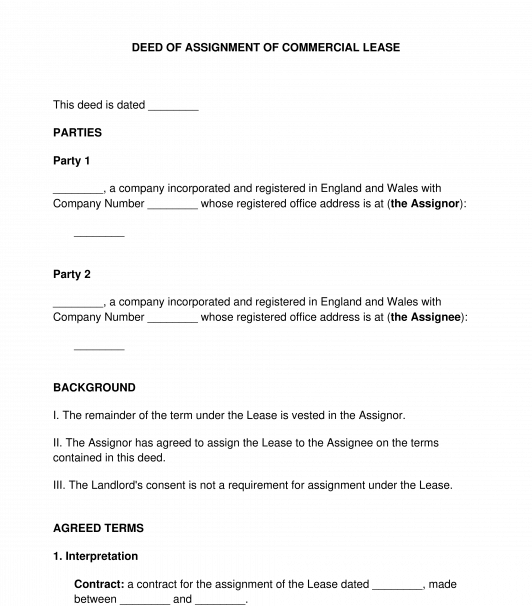
How does it work?
1. choose this template.
Start by clicking on "Fill out the template"
2. Complete the document
Answer a few questions and your document is created automatically.
3. Save - Print
Your document is ready! You will receive it in Word and PDF formats. You will be able to modify it.
Deed of Assignment - Commercial Lease
A Deed of Assignment for a Commercial Lease allows the Tenant of a commercial property with an existing commercial lease, to transfer the legal interest of the Tenant in that commercial property to another individual , company or partnership. This means that after the assignment, the original tenant under the commercial lease will no longer be the tenant of the commercial property and the person to who the lease is transferred will become the new tenant of the commercial property. As a consequence, the Tenant (also known as the " Assignor ") will have to vacate the commercial property, which will then be occupied by another person (known as the " Assignee "). The Assignee upon taking over the occupation of the commercial property will have to adhere to the terms contained in the lease including the amount of rent, the duration of the lease, payment schedules and other undertakings.
A Deed of Assignment can be beneficial to the Assignor in that it grants them the opportunity to leave the leased property before the expiration of the agreed termination date of the lease . This can be particularly useful where the Assignor judges that it will not be able to keep up with rent payments for the remainder of the lease due to economic constraints and wishes to completely let go of the property, or where the Assignor comes to the decision that it does not need the lease anymore for its business and wishes to transfer it completely to another party without retaining any rights to the property.
This template can be used to create such a Deed of Assignment for a commercial lease. This Deed of Assignment makes provision for the Assignee to pay a fee to the Assignor, which in effect is like a price which the Assignee is using to buy the rights of the commercial lease from the Assignor. This fee is known as the Premium . The Deed of Assignment also makes provision for the event where the Assignee will cover any additional costs the Assignor may incur as a result of the assignment, such as legal costs or any incidental costs that are separate from the Premium . An example of how this applies is where the Assignor hires a solicitor to provide legal advice and oversee the assignment of the lease, the Assignor may wish for the Assignee to be the one to pay for the costs incurred in hiring a solicitor. This cost will not form part of the Premium but rather an additional cost that the Assignor will bear and may therefore prefer for the Assignee to cover such cost.
This template also makes note of the persons who were parties to the commercial lease. Where there was a guarantor for the original Tenant, that person will not be a party to this assignment. The guarantor's identity is only noted in this template to accurately list all the parties to the commercial lease for record and documentary purposes.
A Deed of Assignment is a legally binding contract between all the interested parties, including the Assignor, the Assignee and the Landlord (i.e. the Owner of the commercial property). Before a commercial property can be assigned, the landlord's consent will usually be required. Similarly, the Commercial Lease will usually preclude the Assignor (i.e. the Tenant under the Commercial Lease) from assigning the lease unless the landlord expressly consents to such assignment. Under UK law, a landlord is under an implied duty to consent to the assignment of the lease unless it would be unreasonable to do so. Such consent should be given in within a reasonable time and it should be given in writing, although there is no strict format that this written notice must follow. In the rare case where the commercial lease does not state whether the assignment of the lease is subject to the landlord's consent, it will mean that the Assignor can assign the lease without the need for such landlord's consent. It is therefore important to refer to the commercial lease concerned and confirm what the lease's provisions are regarding its assignment and the landlord's consent. Where the landlord's consent is required for the assignment of the lease, the original Tenant should contact the landlord to address matters and request that consent is given. The manner with which the Original tenant should inform the landlord about the assignment of the lease and request consent will be contained in the commercial lease.
This Deed of Assignment can only be used where the commercial property is located in the jurisdiction of England and Wales .
This template can be used where the assignment of the lease applies to either of the two scenarios:
- Where the term of the commercial lease has not expired and there is still time remaining. For example where the commercial lease was for 6 years and the original Tenant has only used 3 years, with 3 years of the term left unused.
- Where the term of the commercial lease has expired but the original Tenant is still in possession of the property. This scenario is called a continuation of the lease. A continuation of the lease can occur either through an application made by the original Tenant to the court or it can occur automatically under statutory provisions.
Note: This document should only be used where the commercial lease is an unregistered lease . An unregistered commercial lease is a lease which was granted for a period of 7 (seven) years or less . Under UK law, if a commercial lease is for a period of more than 7 years, it has to be registered at the Land Registry. Where the lease is a registered lease and the original Tenant wishes to assign the lease, the TR1 form should instead be used.
Differences between a deed of assignment and a commercial sublease agreement
Under an assignment of a commercial lease, the Tenant (i.e. the Assignor) ceases to be liable for any breaches of the original lease and the responsibility for liability is legally transferred to the Assignee from the date of assignment. Whereas, under a commercial sublease, the Tenant (i.e. the Sublandlord) remains liable under the original lease for any breaches that may be committed by the party who is subleasing (i.e. the Subtenant). Under an assignment of a commercial lease, the Tenant (i.e. the Assignor) will not share the property with the Assignee , rather the Assignee will enjoy full possession of the commercial property from the date of assignment until the end of the term of the commercial lease. Whereas, under a commercial sublease, it is commonplace for the Tenant (i.e. Sublandlord) to only sublease a portion of the commercial property to the Subtenant and thus continue in shared possession of the commercial property with the Subtenant.
How to use this document
This Deed of Assignment allows the user to input all of the required rights and responsibilities that are necessary to assign the commercial property to an Assignee. The document allows a user to :
- input the address of the commercial property;
- the amount of Premium to be paid by the Assignee;
- the method of payment of the Premium;
- the date of the landlord's consent (if applicable);
- the details of any additional costs;
- whether the Assignee will indemnify the Assignor for losses;
- whether there is another agreement that also addresses the assignment of the lease;
- what type of title guarantee is being assigned; and
- other important details.
After the document has been filled out, it should be printed and signed by the parties. Consequently, each party should hold a copy of the signed deed for reference purposes.
As this Deed of Assignment relates to an interest in land, it is required to be executed as a deed . This means that it must be in writing and must be signed in the presence of a witness . If the party is a company, instead of a witness, the deed can be signed by two directors or by a director and the company secretary.
Applicable Law
Landlord and Tenant (Covenants) Act 1995
Law of Property (Miscellaneous Provisions) Act 1994
Landlord and Tenant Act 1954
Law of Property Act 1925
Land Registration Act 2002
How to modify the template
You fill out a form. The document is created before your eyes as you respond to the questions.
At the end, you receive it in Word and PDF formats. You can modify it and reuse it.
A guide to help you: Signing Documents in England and Wales
Other names for the document:
Commercial Sublease Agreement, Deed of Assignment of Lease, Deed of Assignment of Commercial Lease, Deed of Assignment of Unregistered Lease, Assignment of Commercial Lease
Country: United Kingdom
Commercial Property - Other downloadable templates of legal documents
- Business Lease Agreement
- Commercial Lease (Scotland)
- Sublease Agreement - Commercial Lease
- Formal Complaint to Landlord - Commercial Lease
- Consent for Subleasing of Commercial Premises
- Business Licence to Occupy
- Other downloadable templates of legal documents

Deed of Assignment
Introduction.
Most of the time, when a tenant chooses to leave their property they will do so at the end of the fixed term of the tenancy and they will give you vacant possession of the property when they do.
However, sometimes one of your tenants will want to leave in the middle of a tenancy and the other remaining tenants will want to stay. In these circumstances if you do agree to allow them to leave the agreement, you can provide a new tenancy agreement that starts afresh, or you, the outgoing tenant, the remaining tenants and the replacement tenant can sign a deed of assignment. This will transfer the outgoing tenants interest in the property over to their replacement.
Deeds and signatures
As a deed this document must be signed by all parties but that signature must be witnessed by someone who is not a family member or a party to the agreement. The most appropriate way to do this is to have the witness be physically present in the room as the parties sign the deed.
Members only
Have you forgotten your password?
- Related Content
- Resources Index
- Pre-tenancy
- Creating Your Tenancy
- Managing Your Tenancy
- Ending Your Tenancy
- Looking After Your Property
- Licensing and Local Government
- Energy Efficiency

⛪ Rent deposit assignment
A rent deposit assignment is a legal document that assigns the responsibility for paying the rent on a property from one party to another. This type of assignment is typically used when a tenant is unable to make their rent payments and assigns the responsibility to a third party, such as a family member or friend. The assignment can also be used to assign the responsibility for paying the rent to a new tenant if the original tenant moves out before their lease is up.
Note: Working on a legal issue? Try our AI Legal Assistant - It's free while in beta 🚀
Deed Of Assignment For Rent Deposits (Occupation Lease)
England and Wales
Associated business activities
Lease a property, try the world's most advanced ai legal assistant, today.

Deed of Assignment (Joint Tenants)
Notification.

IMAGES
VIDEO
COMMENTS
10 December, 2023. A Deed of Assignment is a legal document that transfers the ownership rights and interests of a property or asset from one party, known as the assignor, to another party, known as the assignee. It is commonly used in real estate transactions but can also apply to other types of assets such as intellectual property rights ...
A deed of assignment is used as an evidence that a certain transfer transaction has taken place between an assignor and the assignee. It is a document used to show that the assignor has transferred all of their rights, claims, interests, and ownership of a certain property to the assignee. It is a proof of the assignor's promise that they are ...
The deed of assignment is the main document between the seller and buyer that proves ownership in favor of the seller. The party who is transferring his or her rights to the property is known as the "assignor," while the party who is receiving the rights is called the "assignee.". A deed of assignment is required in many different ...
An assignment of a lease is a complete transfer of the right to be the tenant under the lease. The third-party assignee becomes the "tenant" under the lease, taking over all of the leased premises, substituting for the old tenant. When the lease is assigned, the assigner move out permanently and a new tenant moves in for the remainder of the ...
Lease Assignment Agreement. Last revision 01/19/2024. Formats Word and PDF. Size 3 to 4 pages. 4.9 - 137 votes. Fill out the template. A Lease Assignment Agreement is a short document that allows for the transfer of interest in a residential or commercial lease from one tenant to another. In other words, a Lease Assignment Agreement is used ...
The legal template "Deed of Assignment for Rent Deposits (Occupation Lease) under UK law" is a contractual document specifically designed for use in the United Kingdom. This template is primarily used when there is a change in tenancy or the assignment of a lease agreement from one tenant ("assignor") to another tenant ("assignee").
A lease assignment agreement is a legally binding document between a tenant and a new tenant (or a third party). In this, the tenant transfers their rights and obligations of the original lease to the new tenant for the remaining period of the lease. There are many reasons why a tenant might need to assign a lease.
Gather the necessary information on the parties, the asset being assigned, and other relevant details. Draft the Deed of Assignment, taking into account all the necessary details. Make sure the language is clear and unambiguous. Have the Deed of Assignment reviewed by a legal professional.
Your tenancy is transferred by a document that must: say it is a deed. be signed by you and the new tenant. include both your names and addresses . give the council or housing association's details. Your landlord might have a template deed of assignment that they want you to use. Someone independent must: watch you sign the deed. sign it ...
c. the Assignor has performed all duties and obligations and made all payments required under the terms and conditions of the Tenancy Agreement. Breach of Tenancy Agreement by Assignee. 5. Consent to this Assignment will not discharge the Assignor of its obligations under the Tenancy Agreement in the event of a breach by the Assignee. 6.
What is assignment. Assignment is a way that a tenant can transfer their tenancy to another person. On assignment, the assignor's legal interest in a property is passed to the assignee who takes over that interest and becomes the tenant. All the terms of the original tenancy agreement apply to both the new tenant and the landlord, including the ...
The deed of assignment tenancy is crucial as it protects the interests of all parties involved and provides legal clarity. The Meaning of 'Assignment' in Rent Context. In the context of renting, 'assignment' refers to transferring the existing tenant's lease obligations and rights to another party. The assignee assumes responsibility ...
of a Deed of Assignment or a new tenancy agreement. 3.4 The New Tenant Jointly and Severally promises the Original Tenant that they will pay the Rent stated in the Agreement and perform and observe all the obligations of the Tenant contained in the Agreement. 3.5 The New Tenant as a group and individually promise to compensate the Original ...
A Deed of Assignment is an instrument of transfer which is used in real estate transactions to transfer legal title or the ownership of a land or building from the title holder (called the assignor) to another called the assignee, usually for a consideration (money or money's worth). The title transfer is done in writing, signed, sealed and delivered by the parties to the transaction.
1. you need the consent of the landlord to the assignment; 2. the assignee is paying a "premium" to the assignor for the assignment of the lease, i.e. it is buying the lease from the assignor (or vice versa, i.e. a "reverse premium"); and. 3. the tenant can claim another lease on its expiry (called "security of tenure").
A deed of assignment can be used by property owners to assign their beneficial interest to another party; either a legal owner or a non-legal owner. Most commonly the transfer is between husband and wife for tax purposes on a buy to let. Where a property is held as joint tenants and the parties want to assign beneficial interest, then they must ...
Formats Word and PDF. Size 3 to 5 pages. Fill out the template. A Deed of Assignment for a Commercial Lease allows the Tenant of a commercial property with an existing commercial lease, to transfer the legal interest of the Tenant in that commercial property to another individual, company or partnership. This means that after the assignment ...
In these circumstances if you do agree to allow them to leave the agreement, you can provide a new tenancy agreement that starts afresh, or you, the outgoing tenant, the remaining tenants and the replacement tenant can sign a deed of assignment. This will transfer the outgoing tenants interest in the property over to their replacement.
The legal template "Deed of Assignment for Rent Deposits (Occupation Lease) under UK law" is a contractual document specifically designed for use in the United Kingdom. This template is primarily used when there is a change in tenancy or the assignment of a lease agreement from one tenant ("assignor") to another tenant ("assignee").
A response notice template is available on the Tenancy Services website.1. From 11 February 2021 assignment may only be prohibited in a tenancy agreement if the landlord is a social housing landlord as described in section 53B(1)(a) of the Residential Tenancies Act 1986 or if the tenancy was granted before this date.
PROP.RES.SL.12. This Deed of Assignment (Joint Tenants) can be used to transfer a Tenancy Agreement from one group of Tenants (the Assignors) to a new group of Tenants (the Assignees). If there is only one tenant who is party to the Tenancy Agreement, please use the Deed of Assignment (Single Tenant). This template is for England only.
If a tenant assigns the tenancy without the prior written consent of the landlord, it is an unlawful act. Download request for assignment template [PDF, 43 KB] Download response to request for assignment template [PDF, 61 KB] Landlords can recover expenses. Landlords are entitled to recover reasonable expenses that occur during the assignment ...
Template Deed of Assignment of Tenancy instructions. Once you're about to fill out Deed of Assignment of Tenancy form, remember to have prepared enough of necessary information. It is a mandatory part, as long as errors can bring unpleasant consequences beginning from re-submission of the whole blank and filling out with missing deadlines and ...